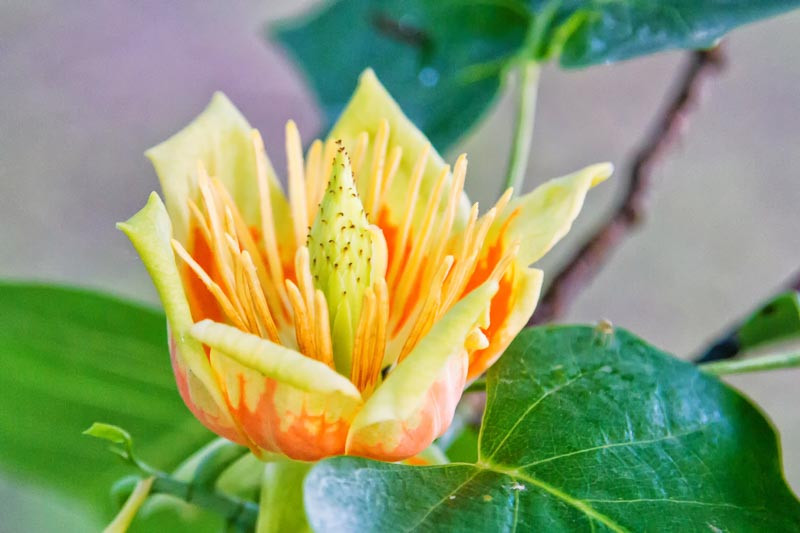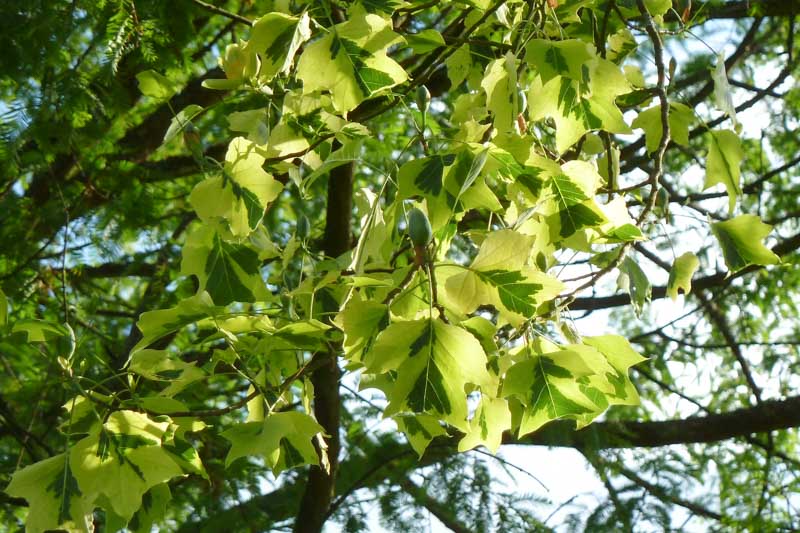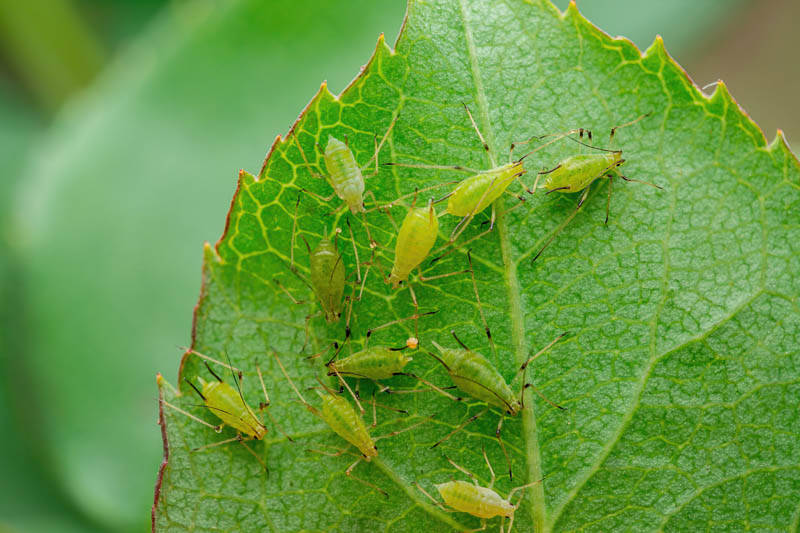Tulip Tree 'Aureomarginatum', Canary Whitewood 'Aureomarginatum', Canoewood 'Aureomarginatum', Lyre Tree 'Aureomarginatum', North American Whitewood 'Aureomarginatum', Saddle Tree 'Aureomarginatum', Tulip Poplar 'Aureomarginatum', Western Poplar 'Aureomarginatum', Whitewood 'Aureomarginatum', Yellow Poplar 'Aureomarginatum', Liriodendron tulipifera 'Majestic Beauty'
Liriodendron tulipifera ‘Aureomarginatum’ (Tulip Tree) is a robust, medium-sized deciduous tree known for its striking variegated foliage and unique tulip-like flowers. It is an excellent shade or specimen tree, adding year-round interest to large landscapes.
Native: The species is native to the eastern United States, from southern Ontario to central Florida and as far west as the Mississippi River.
Plant Type and Habit: It’s a deciduous tree with a pyramidal habit when young, becoming oval-rounded with age.
Size: This is a substantial tree, often attaining heights of 40 to 60 feet (12 to 18 meters) with a spread of 15 to 25 feet (4.5 to 7.5 meters).
Flowers: Its show-stopping flowers, about 3 inches across (7 cm), are tulip-like, yellowish-green with an orange band at the base of each petal, giving it its name. They give way to cone-like fruits that provide winter interest.
Bloom Time: The Tulip Tree blooms from late spring to early summer, offering a short but spectacular display.
Foliage: The glossy foliage of 4-lobed leaves is margined with yellow and quite striking. It turns brilliant golden yellow in the fall, providing both shade and seasonal color.
Hardiness: It’s generally hardy in USDA zones 4-9, though it prefers a moderate climate and struggles with extreme cold or heat.
Award: The Tulip Tree is the recipient of the prestigious Award of Garden Merit of the Royal Horticultural Society.
Uses: It’s often used for timber because of its straight grain but also serves as a stunning ornamental tree in large gardens or parks.
Wildlife: The tree attracts bees, butterflies, and hummingbirds during its bloom period, and its seeds are a food source for squirrels and birds. This is also a favorite nesting tree for birds.
Deer and Rabbits: Generally resistant to deer and rabbits, making it a reliable choice in areas where these animals are common.
Toxicity: The Tulip Tree is generally considered non-toxic to humans and animals.
Drought: It does not tolerate drought and thrives best in consistently moist, well-drained soils.
Invasiveness: Generally not considered invasive, but it’s essential to check local guidelines as conditions can vary.
Benefits: Beyond its ornamental value, the Tulip Tree also offers environmental benefits like carbon sequestration and providing habitats for various wildlife. Its wood is also commercially valuable.

Growing and caring for Liriodendron tulipifera, commonly known as the tulip tree or tulip poplar, is generally straightforward, but there are some key considerations to keep in mind:
Choose a sunny location with room for the tree to grow, as mature specimens can reach heights of 60-80 feet (18-24 meters) or more. Tulip trees prefer organically rich, moist, slightly acidic well-drained soil.
Spring and fall are the best times to plant. Dig a hole about 2-3 times as wide as the root ball but no deeper. Place the tree in the hole, ensuring it is at the same soil level as it was in the container. Fill the hole with soil and water thoroughly.
Newly planted tulip trees require regular watering to help establish their root systems. The soil should be kept consistently moist but not waterlogged. The tree rarely does well in very wet or very dry situations.
An annual application of balanced fertilizer in the spring can help young trees grow strong and healthy. Established trees usually do not require much fertilization.
Young tulip trees may need some formative pruning to develop a strong structure. Avoid pruning mature trees unless removing dead or diseased wood, as this can make the tree more susceptible to disease.

Propagating a tulip tree (Liriodendron tulipifera) can be done through seeds or cuttings Below are some guidelines for each approach:

Tulip trees are generally free from serious pests and diseases, but aphids, scale, and mildew can occasionally be a problem. Monitor regularly and treat as necessary.
Tulip trees can suffer from a range of issues. Here are some common problems:
It’s essential to correctly identify the problem affecting your tulip tree to treat it effectively. Many issues can be managed with good cultural practices, including proper watering, fertilization, and spacing. However, for severe infestations or diseases, chemical treatments may be necessary. Always consult a local arborist or extension service for the most accurate diagnosis and treatment options.
| Hardiness |
4 - 9 |
|---|---|
| Heat Zones |
2 - 9 |
| Climate Zones | 2, 2A, 2B, 3, 3A, 3B, 4, 5, 6, 7, 8, 9, 10, 11, 12, 14, 15, 16, 17, 18, 19, 20, 21, 22, 23, 24 |
| Plant Type | Trees |
| Plant Family | Magnoliaceae |
| Genus | Liriodendron |
| Common names | Tulip Poplar, Tulip Tree |
| Exposure | Full Sun |
| Season of Interest |
Spring (Mid, Late) Summer (Early, Mid, Late) Fall |
| Height |
40' - 60' (12.2m - 18.3m) |
| Spread |
15' - 25' (4.6m - 7.6m) |
| Maintenance | Low |
| Water Needs | Average |
| Soil Type | Clay, Loam, Sand |
| Soil pH | Acid, Neutral |
| Soil Drainage | Moist but Well-Drained, Well-Drained |
| Characteristics | Plant of Merit, Showy |
| Tolerance | Deer, Rabbit, Clay Soil, Wet Soil |
| Garden Styles | Prairie and Meadow |
| Hardiness |
4 - 9 |
|---|---|
| Heat Zones |
2 - 9 |
| Climate Zones | 2, 2A, 2B, 3, 3A, 3B, 4, 5, 6, 7, 8, 9, 10, 11, 12, 14, 15, 16, 17, 18, 19, 20, 21, 22, 23, 24 |
| Plant Type | Trees |
| Plant Family | Magnoliaceae |
| Genus | Liriodendron |
| Common names | Tulip Poplar, Tulip Tree |
| Exposure | Full Sun |
| Season of Interest |
Spring (Mid, Late) Summer (Early, Mid, Late) Fall |
| Height |
40' - 60' (12.2m - 18.3m) |
| Spread |
15' - 25' (4.6m - 7.6m) |
| Maintenance | Low |
| Water Needs | Average |
| Soil Type | Clay, Loam, Sand |
| Soil pH | Acid, Neutral |
| Soil Drainage | Moist but Well-Drained, Well-Drained |
| Characteristics | Plant of Merit, Showy |
| Tolerance | Deer, Rabbit, Clay Soil, Wet Soil |
| Garden Styles | Prairie and Meadow |
How many Liriodendron tulipifera ‘Aureomarginatum’ (Tulip Tree) do I need for my garden?
| Plant | Quantity | |
|---|---|---|
| Liriodendron tulipifera ‘Aureomarginatum’ (Tulip Tree) | N/A | Buy Plants |
Create a membership account to save your garden designs and to view them on any device.
Becoming a contributing member of Gardenia is easy and can be done in just a few minutes. If you provide us with your name, email address and the payment of a modest $25 annual membership fee, you will become a full member, enabling you to design and save up to 25 of your garden design ideas.
Join now and start creating your dream garden!
Create a membership account to save your garden designs and to view them on any device.
Becoming a contributing member of Gardenia is easy and can be done in just a few minutes. If you provide us with your name, email address and the payment of a modest $25 annual membership fee, you will become a full member, enabling you to design and save up to 25 of your garden design ideas.
Join now and start creating your dream garden!